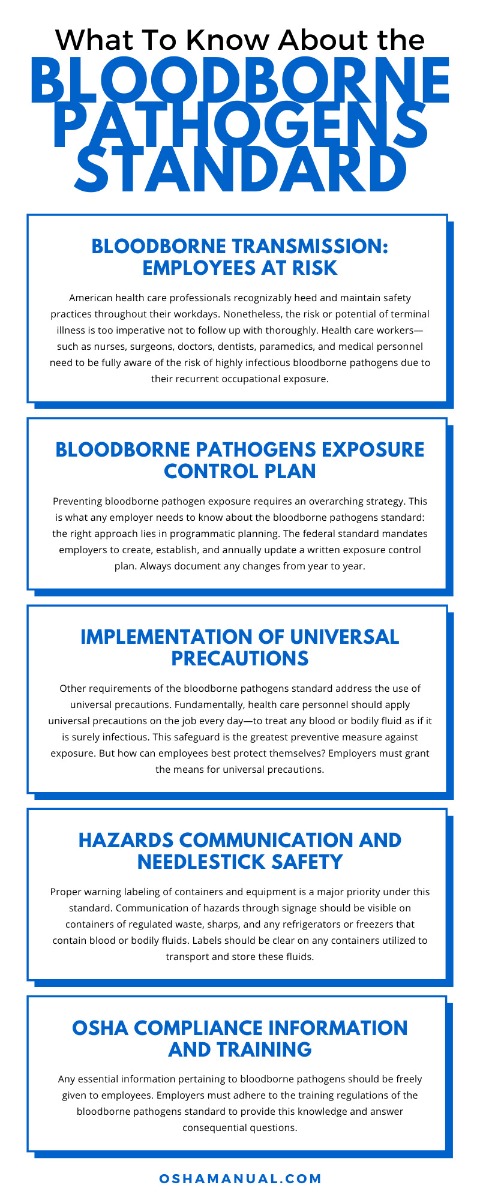
OSHA—the Occupational Safety and Health Administration—supports the comprehensive health and well-being of the nation’s workforce. OSHA upholds numerous enforcement policies specifically regarding the health care industry. The Occupational Exposure to Bloodborne Pathogens is one such standard formulated to protect American workers. This standard relates to exposure to HIV, HCV, HBV, and other bloodborne pathogens that may result in serious illness, disability, or death. As these incurable viruses and other microorganisms that cause bloodborne diseases stem from human blood and other bodily fluids, protection is of the essence for those employed in high-risk health care settings.
This standard began as a proposal alongside the Centers for Disease Control (CDC) and the Department of Health and Human Services (HHS). As a response to the increase of transmitted bloodborne diseases—and recognition of the serious hazardous exposure to millions of workers—OSHA published this regulatory legislation in 1991. At the time of issue, OSHA predicted thousands of infection preventions each year. Past data reveals these regulations as momentous success applicable towards employee health and safety.
Present-day, OSHA persists in addressing needlestick and sharps concerns. Needlesticks continue to account for the majority of occupational exposures to blood. Employers must follow the standard’s requirements and utilize controls and best practices to reduce or eliminate employee exposure. Read on to learn more about the strategies and provisions of this OSHA regulation. Here is what to know about the bloodborne pathogens standard.
Bloodborne Transmission: Employees at Risk
American health care professionals recognizably heed and maintain safety practices throughout their workdays. Nonetheless, the risk or potential of terminal illness is too imperative not to follow up with thoroughly. Health care workers—such as nurses, surgeons, doctors, dentists, paramedics, and medical personnel need to be fully aware of the risk of highly infectious bloodborne pathogens due to their recurrent occupational exposure. Keep in mind that more than frontline health care workers are at risk—anyone who could by some means or another come into contact with human blood or bodily fluids is vulnerable, such as maintenance, janitorial, housekeeping, laundry, or waste disposal workers.
Bloodborne pathogens are transmittable through a myriad of methods. They most often spread through droplet transmission or direct or indirect contact—essentially, whenever blood or bodily fluids of an infected individual gain entry into another person’s body through cuts, puncture wounds, bites, or mucous membranes. The greater part of exposures do not manifest into transmitted diseases—the ultimate risk depends on an assortment of environmental variables. These factors are typically preventable with the right procedures and protocols set in place.
Bloodborne Pathogens Exposure Control Plan
Preventing bloodborne pathogen exposure requires an overarching strategy. This is what any employer needs to know about the bloodborne pathogens standard: the right approach lies in programmatic planning. The federal standard mandates employers to create, establish, and annually update a written exposure control plan. Always document any changes from year to year. Any critical updates reflect changes in tasking, staffing, procedures, technology, or commercially available medical devices.
As a core requirement, an exposure control plan outlines how an employer will either eradicate or minimize exposure to blood or bodily fluids, such as universal engineering practices, work practice controls, personal protective equipment, laboratory functions, biohazard waste disposal, and labeling. This written documentation also encompasses a comprehensive list of your employees whose job classifications, tasks, and duties make them vulnerable to prevalent exposure. Supplementarily, this exposure plan must contain a schedule for compliance, detailed recordkeeping, and determination of the procedure for exposure incident evaluation.
Implementation of Universal Precautions
Other requirements of the bloodborne pathogens standard address the use of universal precautions. Fundamentally, health care personnel should apply universal precautions on the job every day—to treat any blood or bodily fluid as if it is surely infectious. This safeguard is the greatest preventive measure against exposure. But how can employees best protect themselves? Employers must grant the means for universal precautions.
The goals of this OSHA standard are clear, yet facets of the rule grant employers flexibility in selecting appropriate precautionary methods for reaching these health and safety goals. Employers can utilize various engineering controls and work practices to reduce employee exposure at their specific facility. Tailoring procedures and protocols to workplace conditions is a key strategy for effective results.
Appropriate handling and disposal lower the overall possibility of exposure. Don’t forget about making HBV vaccines available and providing personal protective equipment. Any PPE must be given at no cost to employees and cleaned and replaced when necessary. Ensuring proper task performance and verifying correct labeling and signage are also vital universal precautionary measures.
Needlestick Safety
In regard to sharps handling hazards, OSHA revised the bloodborne pathogens standard to incorporate the Needlestick Safety and Prevention Act in 2000. This integral revision provided further detailed requirements about sharps handling protocol. Employers must additionally consider the use of advanced tech or safer medical devices. Newer technologies are changing the face of this standard present-day, alongside employee feedback. Employee awareness and input play a major role in exposure control.
OSHA Compliance Information and Training
Any essential information pertaining to bloodborne pathogens should be freely given to employees. Employers must adhere to the training regulations of the bloodborne pathogens standard to provide this knowledge and answer consequential questions.
Bloodborne pathogens training is mandatory for individuals exposed to blood, bodily fluids, or other potentially infectious materials in their occupation. Employers must provide this training initially upon employee hire and regularly every year after. Compliance training should always be at the appropriate level and language for any employees in attendance.
Turn to Gamma Compliance Solutions for your OSHA compliance needs. Our mission is to help provide a safe and healthy workplace with user-friendly training and program manuals for medical facilities. At Gamma Compliance, our solutions have your needs fully covered. With fully updated safety plans and OSHA policies, our latest online OSHA medical training contains over 15 course topics, including the bloodborne pathogens standard with case studies. Browse our all-in-one solutions packages for your medical settings today.


